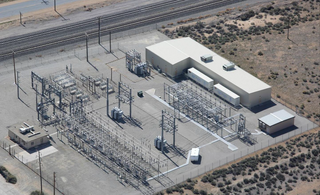
A Beowulf cluster is a computer cluster of what are normally identical, commodity-grade computers networked into a small local area network with libraries and programs installed which allow processing to be shared among them. The result is a high-performance parallel computing cluster from inexpensive personal computer hardware.
The Globus Toolkit is an open-source toolkit for grid computing developed and provided by the Globus Alliance. On 25 May 2017 it was announced that the open source support for the project would be discontinued in January 2018, due to a lack of financial support for that work. The Globus service continues to be available to the research community under a freemium approach, designed to sustain the software, with most features freely available but some restricted to subscribers.

High-performance computing (HPC) uses supercomputers and computer clusters to solve advanced computation problems. Today, computer systems approaching the teraflops-region are counted as HPC-computers.
Oracle Grid Engine, previously known as Sun Grid Engine (SGE), CODINE or GRD, was a grid computing computer cluster software system, acquired as part of a purchase of Gridware, then improved and supported by Sun Microsystems and later Oracle. There have been open source versions and multiple commercial versions of this technology, initially from Sun, later from Oracle and then from Univa Corporation.
GRIB is a concise data format commonly used in meteorology to store historical and forecast weather data. It is standardized by the World Meteorological Organization's Commission for Basic Systems, known under number GRIB FM 92-IX, described in WMO Manual on Codes No.306. Currently there are three versions of GRIB. Version 0 was used to a limited extent by projects such as TOGA, and is no longer in operational use. The first edition is used operationally worldwide by most meteorological centers, for Numerical Weather Prediction output (NWP). A newer generation has been introduced, known as GRIB second edition, and data is slowly changing over to this format. Some of the second-generation GRIB are used for derived product distributed in Eumetcast of Meteosat Second Generation. Another example is the NAM model.

Mercurial is a distributed revision control tool for software developers. It is supported on Microsoft Windows and Unix-like systems, such as FreeBSD, macOS, and Linux.
Rocks Cluster Distribution is a Linux distribution intended for high-performance computing (HPC) clusters. It was started by National Partnership for Advanced Computational Infrastructure and the San Diego Supercomputer Center (SDSC) in 2000. It was initially funded in part by an NSF grant (2000–07), but was funded by the follow-up NSF grant through 2011.

Univa was a software company that developed workload management and cloud management products for compute-intensive applications in the data center and across public, private, and hybrid clouds, before being acquired by Altair Engineering in September 2020.
Kepler is a free software system for designing, executing, reusing, evolving, archiving, and sharing scientific workflows. Kepler's facilities provide process and data monitoring, provenance information, and high-speed data movement. Workflows in general, and scientific workflows in particular, are directed graphs where the nodes represent discrete computational components, and the edges represent paths along which data and results can flow between components. In Kepler, the nodes are called 'Actors' and the edges are called 'channels'. Kepler includes a graphical user interface for composing workflows in a desktop environment, a runtime engine for executing workflows within the GUI and independently from a command-line, and a distributed computing option that allows workflow tasks to be distributed among compute nodes in a computer cluster or computing grid. The Kepler system principally targets the use of a workflow metaphor for organizing computational tasks that are directed towards particular scientific analysis and modeling goals. Thus, Kepler scientific workflows generally model the flow of data from one step to another in a series of computations that achieve some scientific goal.

A computer cluster is a set of computers that work together so that they can be viewed as a single system. Unlike grid computers, computer clusters have each node set to perform the same task, controlled and scheduled by software.
Eucalyptus is a paid and open-source computer software for building Amazon Web Services (AWS)-compatible private and hybrid cloud computing environments, originally developed by the company Eucalyptus Systems. Eucalyptus is an acronym for Elastic Utility Computing Architecture for Linking Your Programs To Useful Systems. Eucalyptus enables pooling compute, storage, and network resources that can be dynamically scaled up or down as application workloads change. Mårten Mickos was the CEO of Eucalyptus. In September 2014, Eucalyptus was acquired by Hewlett-Packard and then maintained by DXC Technology. After DXC stopped developing the product in late 2017, AppScale Systems forked the code and started supporting Eucalyptus customers.
GStat is a web application which is aimed at displaying information about grid services, the grid information system itself and related metrics. The system is designed in modular way so that the software can be reused in different application scenarios.
Techila Distributed Computing Engine is a commercial grid computing software product. It speeds up simulation, analysis and other computational applications by enabling scalability across the IT resources in user's on-premises data center and in the user's own cloud account. Techila Distributed Computing Engine is developed and licensed by Techila Technologies Ltd, a privately held company headquartered in Tampere, Finland. The product is also available as an on-demand solution in Google Cloud Launcher, the online marketplace created and operated by Google. According to IDC, the solution enables organizations to create HPC infrastructure without the major capital investments and operating expenses required by new HPC hardware.

OpenStack is a free, open standard cloud computing platform. It is mostly deployed as infrastructure-as-a-service (IaaS) in both public and private clouds where virtual servers and other resources are made available to users. The software platform consists of interrelated components that control diverse, multi-vendor hardware pools of processing, storage, and networking resources throughout a data center. Users manage it either through a web-based dashboard, through command-line tools, or through RESTful web services.

BeeGFS is a parallel file system, developed and optimized for high-performance computing. BeeGFS includes a distributed metadata architecture for scalability and flexibility reasons. Its most important aspect is data throughput.

OpenNebula is a cloud computing platform for managing heterogeneous distributed data center infrastructures. The OpenNebula platform manages a data center's virtual infrastructure to build private, public and hybrid implementations of Infrastructure as a Service. The two primary uses of the OpenNebula platform are data center virtualization and cloud deployments based on the KVM hypervisor, LXD system containers, and AWS Firecracker microVMs. The platform is also capable of offering the cloud infrastructure necessary to operate a cloud on top of existing VMware infrastructure. In early June 2020, OpenNebula announced the release of a new Enterprise Edition for corporate users, along with a Community Edition. OpenNebula CE is free and open-source software, released under the Apache License version 2. OpenNebula CE comes with free access to maintenance releases but with upgrades to new minor/major versions only available for users with non-commercial deployments or with significant contributions to the OpenNebula Community. OpenNebula EE is distributed under a closed-source license and requires a commercial Subscription.
Quantcast File System (QFS) is an open-source distributed file system software package for large-scale MapReduce or other batch-processing workloads. It was designed as an alternative to the Apache Hadoop Distributed File System (HDFS), intended to deliver better performance and cost-efficiency for large-scale processing clusters.
Kubernetes is an open-source container orchestration system for automating software deployment, scaling, and management. Google originally designed Kubernetes, but the Cloud Native Computing Foundation now maintains the project.

SNAMP is an open-source, cross-platform software platform for telemetry, tracing and elasticity management of distributed applications.

The Tehachapi Energy Storage Project (TSP) is a 8MW/32MWh lithium-ion battery-based grid energy storage system at the Monolith Substation of Southern California Edison (SCE) in Tehachapi, California, sufficient to power between 1,600 and 2,400 homes for four hours. At the time of commissioning in 2014, it was the largest lithium-ion battery system operating in North America and one of the largest in the world. TSP is considered to be a modern-day energy storage pioneer with significant accomplishments that have proven the viability of utility-scale energy storage using lithium-ion technology. While originally envisioned as a research and development project, TSP operated as a distribution-level resource for SCE and for calendar year 2020, SCE reported that TSP operated in the wholesale energy market with revenue exceeding operating and maintenance costs. In 2021, SCE began the decommissioning of TSP.









